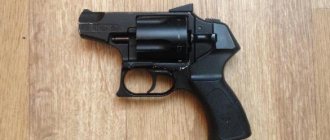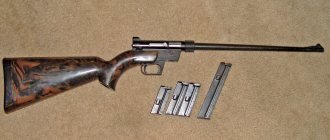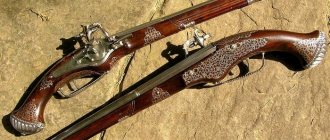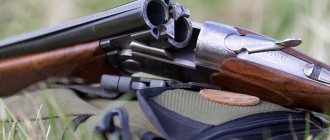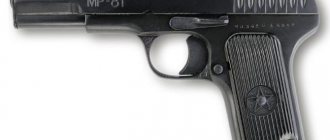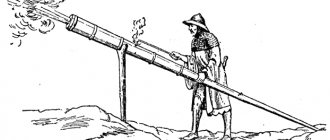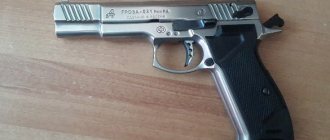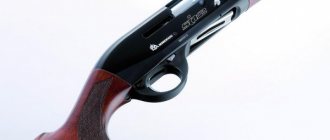Hunting pistols and revolvers are gaining increasing popularity in the civilian weapons market in the United States. Gradually, in other parts of the world, they find a response in the hearts of small arms lovers, primarily due to their versatility. The first to appreciate “pocket shotguns” were farmers. This weapon saved them more than once during unexpected encounters with dangerous snakes. In Russia, gunsmiths are also trying to “keep their finger on the pulse.” What a hunting revolver is, what its pros and cons are, will be briefly outlined in this article.
Versatility
Fierce competition among traditional short-barreled guns is forcing manufacturers to take bold, risky steps. A revolver capable of causing significant damage guarantees a successful hit even in the hands of an inexperienced shooter. This is the main idea when developing hunting revolvers, designed not only for firing 410 caliber for smoothbore guns, but also 45 caliber for rifled guns. Such “omnivorousness” and the low price of ammunition immediately captivated a certain group of people. It is necessary to figure out whether these products are so beautiful, about which various laudatory reviews narrate with aspiration.
A few notes about the 410 gauge
410 caliber is a low-power rifle cartridge. The main advantages are small dimensions and weight, moderate recoil. Here, perhaps, are all its obvious advantages. Many manufacturers produce such a cartridge. The most famous and sought-after of all the variety is with a cast spherical bullet (Foster bullet and, of course, Brenecke bullet).
If this is not a magnum option, then such a cartridge calls into question success in hunting and self-defense. The charge of a bullet, buckshot, or shot in ordinary ammunition is small. Therefore, it is often sold in the “Magnum” or “Semi-Magnum” variant. Their sleeve lengths are 76 mm and 73 mm, while the regular one is only 70 mm.
What happens if you use the 410 Magnum for hunting? The results won't be stunning. If you shoot such a shot load over long distances, then nothing good will come of it. You can somehow get used to the average distance if the shooter is accurate. Buckshot is even worse. With only a few buckshots, it is only suitable for short distances.
In a word, this caliber is very specific.
Pistol for the hunter
photo: Fotolia.com
This saying of Ecclesiastes can easily be applied to hunting pistols. Yes, weapons for defense against dangerous animals are necessary for hunters, geologists, travelers, etc.
The issue of weapons for travelers was raised in ROG several years ago. Then the author proposed a design for a cal. 5.6x39, the axis of the drum was supposed to be the barrel of a 410-caliber shotgun.
Even then, this scheme seemed unsuccessful to me. Firstly, it is too bulky, secondly, these calibers are too weak for defense against dangerous animals, and thirdly, the .410 is not very suitable for hunting.
Revolvers for hunting big game are known and produced throughout the world. But, firstly, legislators are unlikely to allow such weapons (they don’t trust themselves, not to mention their voters), and secondly, the mass of these weapons is very high - 5-6 kg, since they use .454 calibers CASULL, .454WM and others, thirdly, they are very expensive.
Americans also use standard pistols for hunting, but in large calibers. We certainly won't be allowed to do this. So what remains? There is such a weapon. It appeared in India during colonial times. Then the white sahibs hunted tigers.
Even a mortally wounded tiger could not only rush at the enemy, but even jump onto the back of an elephant, where the offender was sitting. And then the hunter was saved by the “howdah”. The word "howdah" in Indian means elephant saddle. "Howdah" in relation to weapons can be translated as "elephant saddle pistols."
At first they were smooth-bore, without sights, since they had to be fired almost point-blank. Then they began to make rifled ones, often the caliber of the “haudaks” coincided with the caliber of the hunter’s main weapon. Sighting devices also appeared on them.
English officers used them not only for hunting, but also in combat, as they were believed to be more reliable than a standard revolver. “Haudahi” were not only double-barreled, but even four-barreled. The most famous are the “howdahs” of Lancaster, Wilkinson, and Westley Richards. So what is a howdah? To put it simply and shorter, it’s a sawed-off double-barreled hunting rifle with a comfortable pistol grip and sights. Even the Duma members can allow such weapons.
How do I personally see the modern “howdah”? In my opinion, it could be a double-barreled shotgun with vertically or horizontally paired barrels, 20 gauge, barrels 25–35 cm long, rifled, weighing no more than 2 kg. Such a weapon can be carried in a belt holster over clothing.
Now about USM. It can be either with external or internal triggers. In the external hammer version, I see one drawback - the loss of time for cocking the hammers, which is very important when attacked by a dangerous animal. Weapons with internal hammers do not have this drawback, but have another - constantly cocked hammers set the mainspring. This is not fatal if such a weapon is used on a hunt as a safety weapon; 3–5 hours in a cocked state will not damage the springs.
And if with this weapon a geologist goes on a route for weeks, or a commercial hunter goes into the taiga for months, when he can be attacked by a connecting rod not only near, but also in the winter hut itself? Here you can use the same scheme as in OF-93: when the handle is grasped, the mainspring is cocked.
A similar scheme can be borrowed from the company, now deceased, “Nimrod”. Now about the cartridges. The 20 gauge seems optimal to me. The sleeve can be shortened to 65–60 mm. The bullet must be expansive. Is it difficult to establish the production of these weapons? In my opinion, no problem. Now the question is – who needs modern “howdas”?
Firstly, for hunters of dangerous animals. The same boar poses a danger to the hunter. Here the “howdah” can be used to pick up wounded animals, since at close range it is more convenient to maneuver with a short-barreled weapon than with a long-barreled weapon, and even more so in the support, where wounded animals like to lie down. A hunter can use this weapon as a weapon of last resort, as well as for backup during the hunt.
“Howdah” will be needed by geologists and other people working in places where it is possible to encounter dangerous animals, but hunting is not expected. People don’t go into the taiga without weapons, and carrying a gun or carbine with you is not always convenient, and it’s extra weight. This weapon will not be amiss for travelers and fishermen in remote areas of our country.
And if you add a third barrel of .22 WMR or .22 HORNET caliber, then in an extreme situation you can get hazel grouse, black grouse, wood grouse, etc. for food. Moreover, three-barreled guns were developed on the basis of IZH-43 and IZH-27 (though they are not visible for sale). The word is up to legislators and manufacturers.
Igor Suslov March 1, 2016 at 12:00
The best revolver for American judges
There are several companies developing revolvers chambered for hunting cartridges. The most popular are Taurus, Smith and Wesson, Charter Arms, Magnum Research. Each of them has created quite successful models, but the undisputed leader today is Taurus.
Why are the products of this company so popular in the West? The Brazilian Taurus came up with the idea of using a rifle and revolver cartridge in one weapon without changing the barrel. This was embodied in their main brainchild - the 4510 revolver. This marking most fully reflects its versatility (45 Colt and 410 caliber rifle cartridge). Their diameter is the same. It was even almost classified as a shotgun. The existing barrel rifling helped, and, to the delight of the creators, it was classified as a conventional weapon.
The model was immediately positioned as the most optimal means of self-defense. Shot charges disperse well at a distance of 10-15 meters. You don't even need to really aim. You can also use 45 Colt ammo, which further increases its range. American judges fell in love with this hunting revolver, and its creators had a reason to call it Judge or “Judge.”
The drum allows you to load 5 rounds. The range of uses for rifle ammunition is truly impressive (spherical bullets, shot, buckshot). But this is not enough. Owners of this miracle load rifle and pistol cartridges into the drum at the same time. This gives them the opportunity to feel confident at medium and close range. And most importantly, it is equipped with a safety lock in case it suddenly falls into the hands of children. Using a screw, the trigger is locked in the frame. It can only be screwed in and out using a miniature hex key.
Firearms for hunting, survival and self-defense
Any sane person understands perfectly well what a significant role civilian weapons play in modern life, especially firearms for hunting, survival and self-defense. Just a disclaimer - we are not discussing the issue of citizens using weapons to maintain law and order, it is a very specific topic... Moreover, in this article we discussed this issue in detail.
So, let's get back to our sheep... Let the narrow-minded hoplophobes and liberal-minded pacifists scream about the unreal horrors and terrible deaths that evil pistols, shotguns and rifles personally caused to them (while demanding that they themselves be protected by other people, and preferably armed ).
But a normal person will go and buy a firearm for hunting, survival or self-defense - you never know what will happen. As they say - “Prepare for the worst, hope for the best!”
And here a logical question arises...
How to choose a firearm for hunting, survival and self-defense?
The problem is that hunting weapons are not always suitable for self-defense, and vice versa, but survival weapons are a different story altogether. Let's just say - there is no such option that all three tasks - hunting, survival and self-defense, can be completed 100%. Something will have to be sacrificed somewhere. But a suitable solution can always be found.
Before we move directly to the recommendations, let's look at the main weapon options.
Gun
There are traumatic pistols (as civilian weapons are allowed in Russia and some CIS countries), there are combat pistols (as civilian weapons - prohibited in Russia and the CIS, permitted in America, many European countries, the Baltic states, etc.).
Even as a weapon for self-defense, a traumatic pistol is downright bad. Especially considering the climatic conditions and the clothes that people wear in countries that are not the hottest. They generally try to talk about hunting and survival with injury in a whisper and when there is no one around.
Combat pistols, that is, normal short-barreled firearms, would be much preferable. You can even somehow hunt, especially if you use special modules to transform the pistol into something similar to a carbine.
But for now one can only drool over such pistols and slowly promote the idea of the need for civilian short-barreled firearms to the masses. So the next option is...
Smoothbore firearms
As is clear from the title, this is a weapon with a smooth barrel, designed to fire cartridges with shot, buckshot or bullets of 12, 20, .410, etc. caliber. It is also our favorite shotgun.
A smoothbore gun is a good help in home defense, and it is completely legal. However, shot or buckshot have terrible destructive power at close ranges and almost none at medium distances. Bullets - they gain a little in range, but only just a little. And at the same time, buckshot or shot does not have the advantage of a dispersion cone, or otherwise, scree.
As a firearm for hunting, shotguns have been used everywhere for a long time, due to their flexibility of use, destructive power and variety of ammunition. For survival - can be used for the same reasons.
The scattering of shot "forgives" the shooter's mistakes in aiming, but only at close distances. For example, shot is an ideal ammunition when shooting at flying birds.
But what the shotgun lacks is striking range, high accuracy and penetrating ability.
These shortcomings are free...
Rifled firearms
Clarification - we are talking about long-barreled weapons with a rifled barrel, since the barrel of a pistol also has grooves.
A rifled weapon fires a solid-state bullet with a characteristic “cone-shaped” nose. The rifling in the barrel of the weapon gives the bullet rotation around its longitudinal axis, due to which the bullet stabilizes in flight and flies along a ballistic trajectory, very accurately and far.
Another undeniable advantage of rifled weapons is the weight of the ammunition. While 50 12-gauge shotshells weigh about 2.5 kg, the same number of .223-gauge shells weighs just under 600 grams.
It would seem that a carbine with a rifled barrel is an ideal firearm for hunting, survival and self-defense, but there is one small point.
The fact is that the future shooter, hunter or survivalist, by law, will have to start with a smooth-bore weapon. It is believed that a shotgun is simpler, weaker and serves to “gain experience” (but we know what a shotgun really is - editor’s note). And only after the expiration of the 5-year period will it be possible to switch to rifled ones.
Therefore, just like a pistol, let’s leave rifled weapons out of sight for now. Let's assume that a shotgun is the optimal weapon for hunting, survival and self-defense.
Weapon selection criteria
However, even with smooth-bore weapons, everything is not so simple. You can, of course, choose anything, as long as you can shoot, train with him, and then, when the time comes, move on to something serious, but that’s not the point. It’s better to immediately choose a smooth-bore weapon for hunting, which you can, if anything, trust with your life. And when choosing such a tool, you need to pay special attention to the following factors.
Weapon weight
Ideally, a gun should weigh no more than 1/22 of the hunter's weight. If it is more, then it will be difficult to move with it and simply hold it in your hands for a long time.
If it is less, it is more difficult to cope with the recoil. Or the weapon will not be powerful enough.
Balance and comfort
The balance of a weapon and its ergonomics are purely individual qualities. And if one particular barrel doesn’t “fit into the hand” at all, then another will have the feeling that he was born with this weapon. Therefore, just at least hold the gun in your hands, invest yourself, try to aim.
There is another way to check your guesses - if after the shot the barrel returns to the aiming line with ease, then the gun is good. If you have to make additional adjustments, adjust the aiming line, invest and generally spend extra time on aiming, then think about it.
USM
The mainspring must be powerful and produce a clear and loud click after pressing the trigger when there is no cartridge in the chamber. The fuse should be convenient for you and work clearly, turn off and turn on without a hitch.
So, when we decided that we need a long-barreled smooth-bore weapon, we went through the main selection criteria, let’s move on to the main question...
Which firearm to choose for hunting, survival and self-defense?
Let's get three things clear right away. Firstly, we are not here for war, so we ask Vepr/Saiga fans with 24-round drum magazines to moderate their ardor a little.
Secondly, the task of our weapons is indecently simple - hunting birds and small animals, with the likelihood of using the weapon for survival/self-defense, that is, shooting with buckshot or a bullet at large “game”.
Third, and most importantly, such a weapon for hunting, survival and self-defense must be: a) simple, b) resistant to falling/dirt/clogging, etc., c) repairable, and e) cheap.
Therefore, based on these conditions, we will not conduct a large-scale analysis of everything at domestic and foreign weapons dives, but we will tell you about what has long proven itself.
TOZ-34
TOZ-34 is an extremely successful design, developed back in 1964. Since then, it has remained virtually unchanged, except, of course, for some interesting modifications. The original gun was distinguished by a vertical barrel layout, the presence of two triggers and internal hammers, a rigidly fixed fore-end and a fairly comfortable butt. The most popular shotguns were 12 and 28 gauges.
Subsequently, modifications were developed with a rubber butt pad (P), an ejector mechanism (E), chambered for different cartridges (upper - .22LR, lower - .20/70), as well as a single-barrel lightweight version chambered for .12/70
According to reports from the Tula Arms Plant, more than one million TOZ-34 of various modifications were produced. Not bad for a fairly simple hunting rifle.
MR-27
MR-27 , or IZH-27, was created at the Izhevsk Mechanical Plant. By the way, almost one and a half million guns were produced. The most common smoothbore gun among Russian hunters. The barrels are rigidly fixed in the coupling; there are no modifications with interchangeable barrels for different calibers. Currently available in calibers 12/70, 20/70, 32/70, 20/76.
Among the most interesting modifications are models equipped with ejector mechanisms of various types. And also converted to one trigger instead of the usual two.
Hunters appreciate the MP-27 for its simplicity of design, excellent balance, lightness and accuracy.
So if you are planning to purchase a firearm for hunting, survival and self-defense, we recommend that you pay special attention to the two above-mentioned models. It’s a good idea to start with them, and if you fall in love with the weapon, then later you will say “thank you” to it more than once.
PS We are not an encyclopedia or know-it-alls, and we might have missed something. Therefore, if you have something to tell about, write below in the comments. Maybe this is some good trunk that we have undeservedly forgotten about. In short, as per tradition, we propose to discuss the issue.
Taurus Public Defender
Another 410 caliber hunting revolver, but lighter and more compact than its older brother. The drum is identical, designed for 5 rounds. Double-action trigger mechanism: self-cocking and manual pre-cocking. The front sight of the Taurus family is not adjustable. The branded handle is made in combat style.
Another important distinguishing feature of this family is that the barrel and its frame are made from one solid milled blank. The muzzle energy can be twice the norm, but for such revolvers this is not scary.
Powerful double action hunting revolvers
Powerful double-action hunting revolvers are gaining popularity at an incredible rate. On par with crossbows and hunting bows. It seems that hunting is turning from a way of obtaining food into an extreme form of pastime.
Initially, revolvers and pistols were used for hunting mainly in the United States of America. Despite a number of laws restricting their use, more and more passionate amateurs prefer to hunt with handguns. The reason for this is the availability of a large selection of hunting revolvers and pistols. And the most powerful of them are double-action revolvers. To help extreme hunters there are new ammunition for this type of hunting, improved aiming systems and, finally, the “romanticization” of this type of hunting in numerous publications and television programs.
Shooting technique.
Recently, special target hunting revolvers with optical sights have become increasingly in demand. The developers have ensured that the hunter can hold the revolver in a normal position, at arm's length, and not bring the sight eyepiece close to his face. The most reliable way to shoot accurately and comfortably is to hold the revolver with two outstretched hands. The accuracy of the shot increases if the shooter's hands (but in no case the weapon itself) rest on a solid object or rest against it. Installing double-action optical sights on pistols and revolvers significantly increases the range of an aimed shot. For hunting at a long distance to the target, there is no need to fire several shots in a row. After all, the first shot is fired only after particularly careful aiming. In this regard, powerful, long-barreled hunting revolvers, firing single shots, adapted to fire various types of cartridges, have taken an important place in the arsenal of many hunters.
Popular models of revolvers.
Traditionally, hand weapons are used for hunting both small game and large animals. Even the giants of the forest are the target of the hunt: wild boar, bear, elk, deer. The .357 Magnum revolver is deservedly used for hunting elk and deer. But most shooters who prefer hunting large animals tend to buy powerful .44 Magnum hunting revolvers. First of all, this is a Smith and Wesson Model 29 double action revolver. Also popular is the Ruger Blackhawk, which has a simple single-action mechanism that requires you to manually cock the hammer after firing.
Much fewer hunters use the legendary automatic pistol chambered for .45 AKP, or .44 AMP Automag Magnum, which has a longer range, but is quite rare and expensive. As well as the original Thompson Center Contender pistol, which fires single shots. This pistol, in addition to firing conventional pistol cartridges, is adapted to fire rifle cartridges such as .30-30 Winchester and .35 Remington.
Varminting.
A specific type of hunting called “Varminting” is gaining momentum in the world. The objects of hunting are small animals (in English “varmint”). When a hunter talks about revolvers and varmint rifles, he is talking about weapons designed for long-range precision shooting. Some hunters use the same rifles and Magnum revolvers for Varminting hunting as they use for large game hunting. They believe that in this way they train the accuracy of their shooting. Meanwhile, there are shooters who specialize exclusively in Varminting hunting. They use weapons designed for long-range shooting of small animals, believing that this type of hunting is the most exciting and emotional.
Pistols and revolvers made specifically for Varminting hunting have an unusual appearance - they resemble sawn-off shotguns from movies. Considered to be the best for hunters is the Remington XP-100, which is like a short-barreled rifle with a large bolt and pistol grip. The Remington XP-100 fires the .221 Remington centerfire bottle cartridge. A very impressive shot from this weapon, the barrel of which is 27 cm. The bullet weighs 3.25 grams, and the initial flight speed is 800 meters per second. When shooting on a test bench from a Remington XP-100 equipped with an optical sight, you can achieve an accuracy of five shots at a distance of 100 meters within a 2.5 cm circle. This shooting quality, combined with the high initial speed of the bullet, allows you to confidently hit marmots and other small animals from a distance of up to 100 meters.
Hunting revolvers in sport shooting.
But not only hunting is possible with hunting revolvers and pistols. For example, in the United States, sport shooting with pistols and revolvers is divided into three main categories, none of which were related to hunting: target shooting, shooting at police combat tournaments or practical courses, participation in world shooting championships. There is another relatively new category that has many similarities with hunting and has become very popular. This category is known as Metal Animal Silhouette Shooting. It originated in Mexico and quickly spread to the United States and then to Europe.
The rules for shooting steel targets are very simple: you must fire five shots in two and a half minutes, and one point is awarded for each target knocked down. This is much more difficult to do than it seems at first glance. The fact is that the silhouettes are heavy, and the bullet must hit a strictly defined place in order to shoot them down. Simply hitting the target does not lead to a positive result. These competitions also attract the attention of athletes because the target silhouettes resemble living animals. And many who like to shoot with real weapons prefer to fire pistols at targets rather than go out on a real hunt. As you can see, powerful double action hunting revolvers have many uses.
Smith&Wesson Governor
The stunning success of the Judge revolver haunted the monster of the American arms industry - the Smith & Wesson company. They announced their answer - Governor. Its drum is made of steel, the handle is made of various synthetic materials, and when making the frame, scadium was added to the alloy. The new product turned out to be light and durable.
But its main focus is expanding the use of different types of ammunition. There is also the possibility of combining them when charging. What ammunition can you use? This is the same 410 caliber, 45 Colt and 45 ACP.
Drum capacity – 6 cartridges. Its trigger mechanism is double-action (fire can be fired either with self-cocking or with a pre-cocked hammer). Weight without cartridges 839 grams.
Revolver boom
Almost a century after the appearance of the Nagan system revolver of the 1895 model, the development of a new 9-mm revolver began for the USSR Ministry of Internal Affairs. The Soviet Cobalt revolver, which soon became the Russian RSA, never gained fame among law enforcement officers, however, like its other classmates.
Born in USSR
The development of a revolver chambered for 9x18 mm at the Tula Central Design Research Bureau of Sporting and Hunting Weapons (TsKIB SOO) as part of the Cobalt development work (R&D) began by order of the USSR Ministry of Internal Affairs. The documentation for the revolver was ready in 1992 and later transferred to the Zlatoust Machine-Building Plant (ZMZ) to begin mass production.
The variety of designations and indices of one model often creates confusion when discussing a particular pistol or revolver. This happened with the Tula “Cobalt”. At the beginning of development, it had a standard index for TsKIB SOO TKB-0216 (sometimes TKB-216 is found). Then, in the Tula Design Bureau, a new line of indices “OTs - TsKIB Weapons” was opened for development in the interests of law enforcement agencies. The new revolver for the Ministry of Internal Affairs received the first number of the new index system - OTs-01. In addition to indices, it is customary to assign abbreviated names to weapons, reflecting their purpose or the authorship of the developers. So “Cobalt” became RSA (Stechkin-Avraamov revolver). So, in relation to the first Tskibov revolver, you can use any of these names and indices.
Various versions of TKB-0216 zmz.ru
The RSA revolver was not much different in appearance from the American Smith-Wesson revolvers of that time. The latch for fixing the drum was placed in the upper part of the frame for a more reliable fixation - it was this invention that became the main “highlight” of the Tula revolver, reflected in the patent declared by the developers I.Ya. Stechkin and B.V. Avraamov in December 1991. The weapon can be disassembled into several large units, has a simple design, high reliability and safety of use.
In total, two batches of RSA revolvers were produced in Tula with a total quantity of just over two hundred units. Their further production since 1994 has been carried out at the Russian ZMZ and the Kazakh plant in Uralsk. There were two versions of the revolver: with wooden and plastic grips. The PSA kit included three clips, a holster with storage compartments for clips, a shoulder strap and a wiper. Later, instead of a shoulder strap, a separate pouch for three loaded clips appeared in the kit.
An example of wearing a PSA in a standard holster by an employee of the Ministry of Internal Affairs I. Carden
In 1996, the RSA was adopted by the Ministry of Internal Affairs of the Russian Federation, including as a personal weapon for employees of the penal system (in the future it became an independent penitentiary service - the FSIN). Later, in the Ministry of Justice, in addition to employees of the Federal Penitentiary Service, bailiffs began to be armed with revolvers, and in the prosecutor's office - prosecutors and investigators. Despite such an impressive list of possible users of the Tula and then Zlatoust revolver, the RSA did not become as popular as the PM. In addition, the revolver is included in the list of award weapons for citizens of the Russian Federation, numbering only eighteen units of military short-barreled weapons, four of which are of foreign origin.
"Nickel" and "Titan"
In the wake of the interest of law enforcement agencies in the revolving design of pistols, the Tula TsKIB SOO created several more models of military weapons. The next after the OTs-01 was the OTs-11 “Nickel” revolver, also intended for the Ministry of Internal Affairs. This weapon, more compact than the RSA, was intended for concealed carry by law enforcement officers. OTs-11 was developed by designers A.N. Nevizhin and S.V. Zotov. In Tula, they produced a small batch (about a hundred pieces) of such revolvers and handed it over to the customer.
Revolver OTs-11 “Nickel” museum-arms.ru
Thanks to its compactness and the use of light alloys, the revolver weighs just over 0.5 kg. To use the weapon without removing it from a clothing pocket or bag, the design has a semi-hidden trigger. In the first experimental models, the OTs-11 had the usual open trigger mechanism. Like the RSA, the Nickel can fire both with the hammer cocked and self-cocking. In the latter case, the force when pulling the trigger is twice as large, which significantly worsens the accuracy of fire.
Designer Nevizhin subsequently developed several revolver designs and patented many individual structural elements for them. One of these revolvers was the OTs-17 Titan, which is a slightly modified Cobalt. The Titan revolver is larger than the RSA, but the cylinder holds one more cartridge. Thanks to the titanium alloy body, such an increase in size did not lead to an increase in the mass of the weapon, but on the contrary, allowed it to “drop” several tens of grams.
Revolver OTs-17 "Titan" TsKIB SOO
“Nickel” and “Cobalt”, like RSA, were adopted by the Ministry of Internal Affairs of the Russian Federation, but remained rare and small-scale products. Despite some advantages of the revolver and its fairly high popularity among police officers in Western countries, a miracle did not happen in Russian realities. A lot of time has passed since the times of the Russian Smith-Wesson, Galan and even Nagan. The triumphant return of revolvers to the power structures of Russia did not take place and became only an episode in the history of their development.
Gryazev-Shipunov revolver
In 1992, the Tula Instrument Design Bureau (KBP) also developed its own version of the R-92 revolver for the needs of the Ministry of Internal Affairs. Its design was much more original than its predecessors. To reduce the dimensions, the handle relative to the drum was moved forward, and the trigger was also moved there, the translational movement of which increased the accuracy and accuracy of fire. In terms of its purpose, the model is similar to the “Nickel” and also has a semi-hidden trigger. The R-92 revolver, like the RSA, was adopted by several law enforcement agencies and approved as a premium weapon.
Revolver R-92S at a German auction with a starting price of 500 euros hermann-historica.de
In 1994, serial production of the R-92 was launched in Kovrov at the KMZ mechanical plant. However, the revolver did not become widespread in the Ministry of Internal Affairs. Part of the first batch of revolvers was converted into the service version R-92S in 1995. To meet the requirements of the Law on Weapons, it was decided not to change the 9x18 mm cartridge, but to change the design of the chambers - this move allowed the designers to reduce the effective firing range by 20%.
In addition to metal clips, the revolver also included plastic clips. To store and carry three clips there was a plastic pencil case (first rectangular and then cylindrical). However, the R-92S was not produced for long - until about 1996. During this time, about 3,000 pieces of both versions of the revolver were produced. Probably, in the case of a more successful fate, the R-92 could be called the RGSh and bear the name of the famous Tula designers V.P. Gryazev and A.G. Shipunova.
Service revolvers
The revolver boom of the 90s affected all types of the arms industry. Numerous versions of service revolvers, weapons for self-defense (gas and traumatic), and signal means were developed. Almost all variants of military weapons received their service versions, which became more popular and widespread. For the 9x17 mm service cartridge, the TKB-0216S was produced in Zlatoust, the R-92KS in Tula, and the RSL-1 in Kirovsk.
Of the above items, the reader encounters the RSL-1 revolver here for the first time. However, upon closer examination of the weapon, one can see in it the familiar features of the RSA revolver, the gas version of which MTsRG-1 served as the prototype for the Kirov service revolver. However, changes in the design led the weapon not to the Stechkin revolver, but to the classic Smith-Wesson version. In terms of its dimensions, the RSL-1 is almost equal to the small-sized Tula R-92 and OTs-11, externally differing from them mainly in the presence of an open trigger. Other characteristics of the RSL-1 remained almost the same as those of its competitors.
Revolvers MMRT-1, RSL-1 and MTsRG-1 kalashnikov.ru
Later, gas and traumatic versions appeared on the basis of many revolvers. At ZMZ they began to produce TKB-0216T "Agent", in Kirovsk - MMRT-1 "Hornet", and in Tula - in addition to MTsRG-1, also GR-92. Basically, the drum with the chamber for firing new cartridges was altered, but in some cases the trigger mechanism was also changed. All this extended the difficult life of revolvers in Russia for another ten years.
It is worth remembering special gas revolvers. In the early 90s, by order of the Scientific Research Institute of Special Equipment (NIIST) of the Ministry of Internal Affairs of the Russian Federation, work was underway on the creation of special irritating agents. In particular, gas versions of “Smoke” with a caliber of 7.6 mm and “Skunk” with a caliber of 5.6 mm appeared. Such self-cocking revolvers weighed only 300 g and could affect the offender at a distance of up to 2.5 m. Outwardly, they are similar to the Tula TOZ-101 and RS-01 "Scat", probably related to each other.
Kovrov "Rhino" and Izhevsk "Rex"
The most non-standard version of the revolver layout in Russia was proposed by Kovrov gunsmiths. In the special design bureau of KMZ under the leadership of S.I. Koksharov, taking the well-known RSA revolver as a basis, created their own AEK-906, significantly reworking its layout. The Kovrov “Rhinoceros” really began to look unusual and threatening. The barrel was placed opposite the lower chamber of the drum - thereby achieving better balance of the weapon, which had a beneficial effect on shooting accuracy.
Demonstration of the balance of the AEK-906 revolver "Weapons" magazine
This principle of barrel arrangement is not new for revolvers. It can be compared in some ways to an automatic bullpup layout, the disadvantages of which are known to everyone. The obvious advantages of this option outweigh the less obvious disadvantages. When firing from the Rhinoceros, due to the balance being shifted lower relative to the aiming line, the weapon constantly “falls down” during long-term aiming. So accurate and dangerous, but slightly clumsy, like a real rhinoceros, was the Kovrov revolver. However, the security forces were not interested in either the non-standard AEK-906 revolver in 9x18 mm caliber, or the AEK-906-01 variant chambered for a more powerful 9x19 mm cartridge.
One of the last attempts to successfully resolve the fate of the Russian revolver was made by Izhevsk gunsmiths. Unlike previous revolvers, Izhmekh oriented its model for export, which was reflected in its name - “Rex” (“EXPORT Revolver”). The ammunition chosen was the popular Western pure revolver cartridges .357 Magnum and .380 Special. Due to the presence of a rim on the case of such cartridges, there was no need for a special clip, and extraction was carried out automatically when the drum was opened. If necessary, this function could be disabled.
Revolver MP-412 Magazine "Weapons"
The Izhevsk MP-412, made according to the classical canons of long-standing Western revolver traditions, also failed to make a successful career.
A powerful and weighty revolver with a breaking frame, developed by R.G. Shigapov and S.V. The Gulyaevs were not destined to conquer the West. Probably, the problems largely lie in certain import obstacles in local arms markets, which are already crowded with hundreds of high-quality revolvers from more familiar brands. Technical characteristics of revolvers
| RSA | OTs-11 | OTs-17 | R-92 | AEK-906 | |
| Index | OTs-01 | OTs-11 | OTs-17 | – | – |
| Caliber, mm | 9×18 | 9×18 | 9×18 | 9×18 | 9×18 |
| Length, mm | 200 | 158 | 205 | 157 | 210 |
| Height, mm | 136 | 113 | 125 | 115 | 145 |
| Width, mm | 37 | 34 | 40 | 35 | 37 |
| Weight without cartridges, g | 785 / 815 | 550 | 750 | 520 | 800 |
| Weight of loaded clip, g | 65 | 54 | 76 | 100 | 65 |
| Drum capacity, cartridges | 6 | 5 | 7 | 5 | 6 |
Sources:
- 9mm RSA revolver. Technical description and operating instructions TKB-0216 TO – 1992
- 9 mm revolver OTs-01 (TKB-0216). Passport OTs-01PS
- 9-mm service revolver R-92S. Technical description and operating instructions R-92S.00.000 TO
